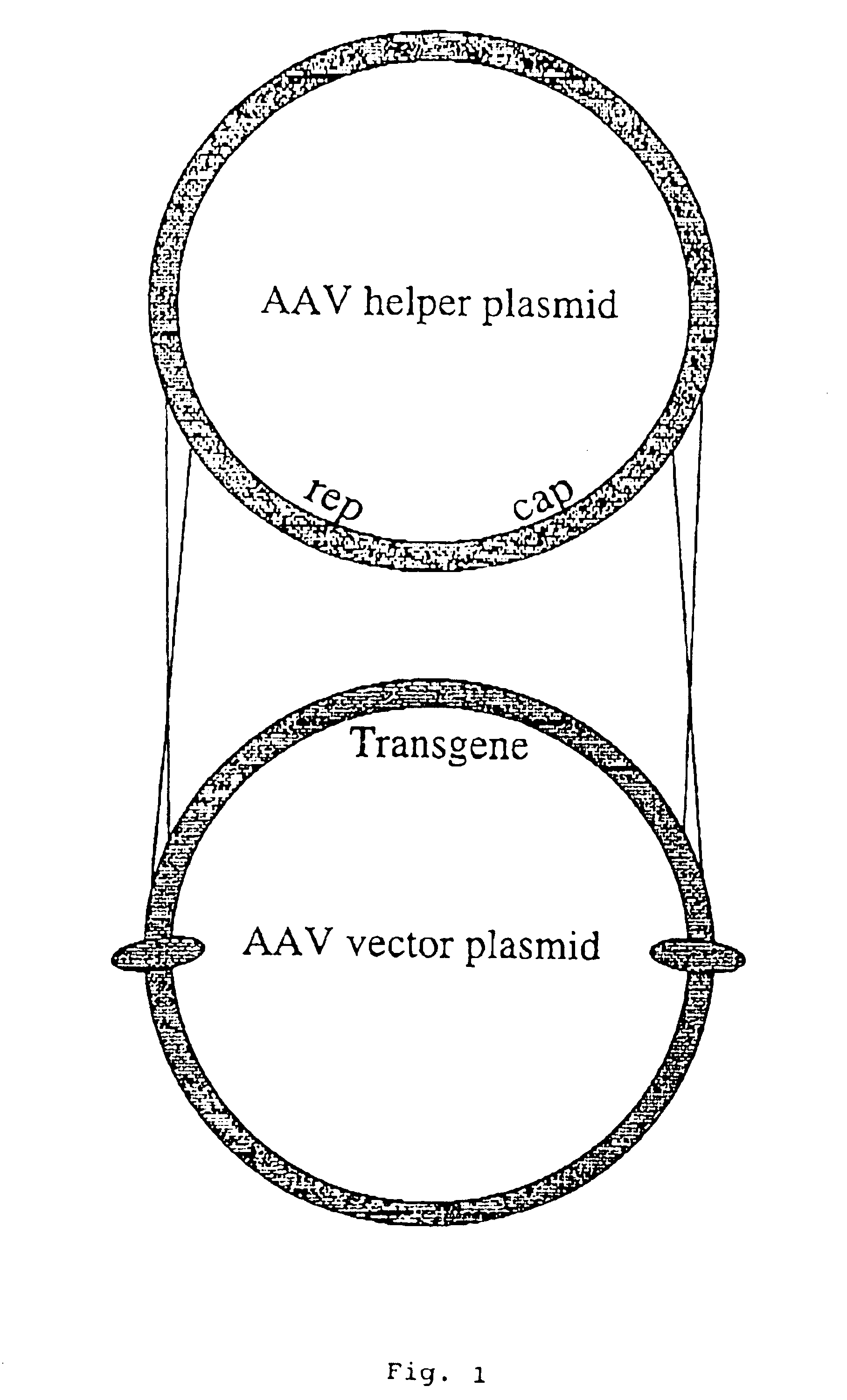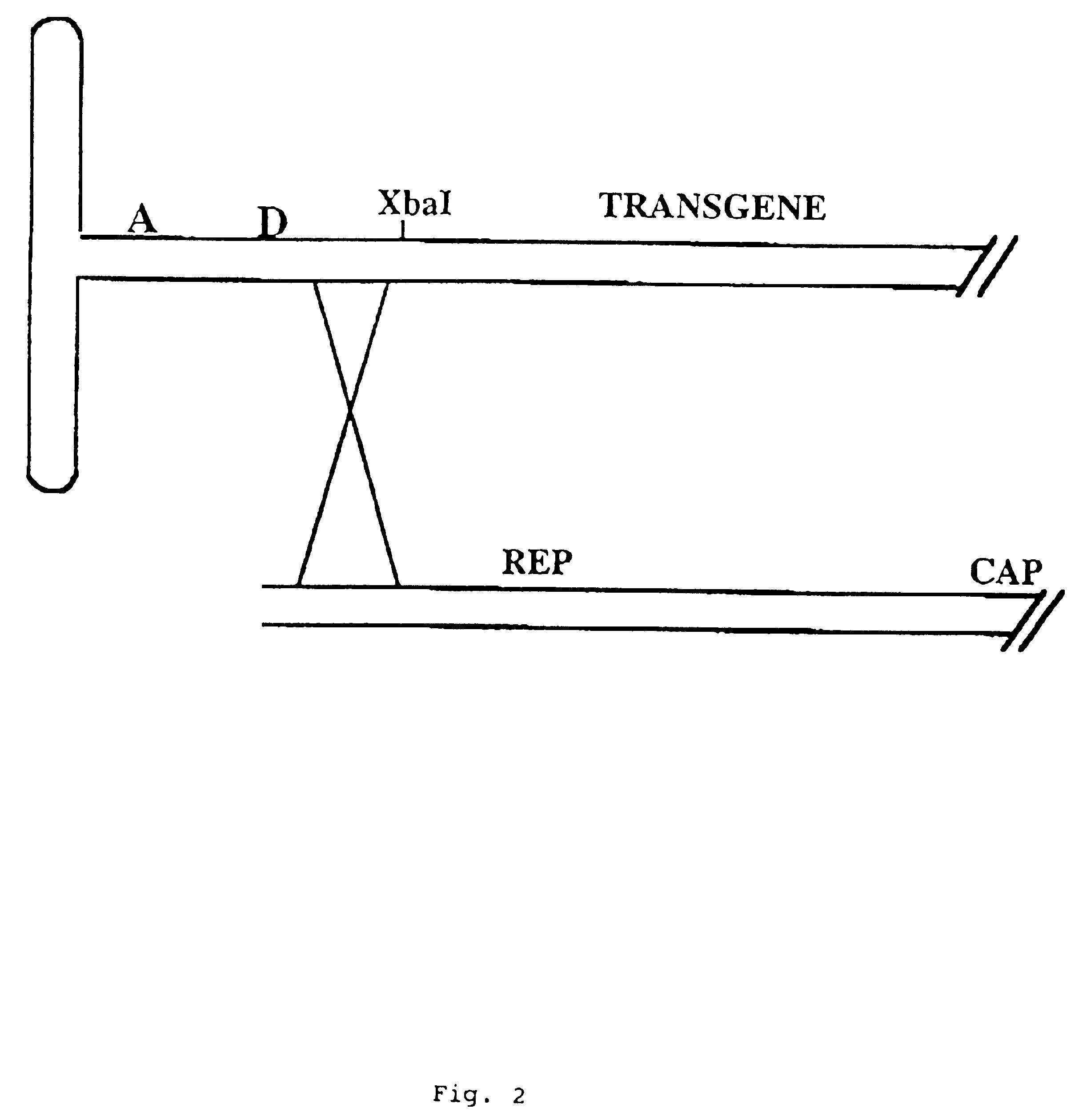Adeno-associated viral vector-mediated delivery of DNA to cells of the liver
a technology of adenovirus and liver, which is applied in the direction of biocide, animal repellents, peptide/protein ingredients, etc., can solve the problems of limited replication and spread of such viruses in vivo, death of neuron, and harmful immune reactions
- Summary
- Abstract
- Description
- Claims
- Application Information
AI Technical Summary
Benefits of technology
Problems solved by technology
Method used
Image
Examples
example 1
CREATION OF A RECOMBINANT ADENO-ASSOCIATED VIRUS (RAAV) VECTOR FOR GENE TRANSFER INTO LIVER
[0130]SSV9-MFG-S-huFIX, depicted in FIG. 11, is constructed by digestion of the SSV9-MFG-S-K9F9 vector with AgeI and BamHI to remove the canine Factor IX sequences, followed by ligation with a 1.6 kbp AgeI / BamHI fragment containing the human factor IX sequence from plasmid MFG-S-huFIX (human FIX). The MFG-S-huFIX vector contains the Moloney murine leukemia virus (MLV) 5′ LTR (MFG), adjacent MLV splice donor / acceptor (S) and the huFIX cDNA sequence connected to the MLV env ATG and a poly(A) site of bovine growth hormone from pRc / CMV(Invitrogen). The huFIX sequence may be obtained from pAFFIXSVNeo (St. Louis and Verma, Proc. Natl. Acad. Sci. USA, 85:3150-3154 (1988)).
[0131]The SSV9-MFG-S K9F9 intermediate vector is derived from pXCJL-K9F9 and SSV9. The SSV9 plasmid (Samulski et al., J. Virol., 63:3822-28 (1989)) is digested with XbaI to remove nearly the entire AAV genome leaving only the termi...
example 2
PACKAGING OF THE RECOMBINANT AAV VECTORS
[0132]The recombinant AAV vectors are packaged as described by Snyder et al., in Current Protocols in Human Genetics, pp. 12.1.1-12.1.24, Dracopoli et al., eds. (John Wiley & Sons, New York, 1996).
[0133]To create rAAV viral vectors, plasmid pSSV9-MFG-S huFIX is co-transfected along with an AAV helper plasmid (which provides necessary AAV replication and structural proteins but lacks AAV termini and thus cannot package into virus) via the calcium phosphate method into 293 cells (Graham et al., J. Gen. Virol., 36:59-74 (1977)), which constitutively express the adenovirus E1a protein. A suitable helper plasmid is pDCG2-1 (Li, Samulski & Xiao, J. Virol., 71:5236-5343 (1997)). The next day, the co-transfected 293 cells are infected with an adenovirus type 5 strain, adenovirus strain dl312 (Jones & Shenk, Cell, 17:683-689 (1979)) to provide remaining replication and packaging machinery. Following full cytopathic effect, virus is harvested by multip...
example 3
ANIMAL PREPARATION
[0134]Either C57BL / 6 mice (immunocompetent) or BALB / c SCID mice (immunocompromised) are used for animal studies. Animals are treated according to the NIH Guidelines for Animal Care and Use. For surgical procedures, animals are anesthetized with 0.5 ml of 20 mg / ml Avertin, a midline abdominal incision is made, the abdominal wall is opened, the portal vein is exposed, a cannula is placed into the portal vein and then the abdomen is sutured closed (Vrancken Peeters et al., BioTechniques, 20:278-285 (1996)). Infusions of the AAV vectors are accomplished by connecting the cannula to a syringe pump at a rate of 200 μl / 10 min.
PUM
| Property | Measurement | Unit |
|---|---|---|
| time | aaaaa | aaaaa |
| volume | aaaaa | aaaaa |
| concentrations | aaaaa | aaaaa |
Abstract
Description
Claims
Application Information
 Login to View More
Login to View More - R&D
- Intellectual Property
- Life Sciences
- Materials
- Tech Scout
- Unparalleled Data Quality
- Higher Quality Content
- 60% Fewer Hallucinations
Browse by: Latest US Patents, China's latest patents, Technical Efficacy Thesaurus, Application Domain, Technology Topic, Popular Technical Reports.
© 2025 PatSnap. All rights reserved.Legal|Privacy policy|Modern Slavery Act Transparency Statement|Sitemap|About US| Contact US: help@patsnap.com



